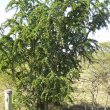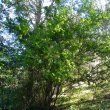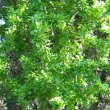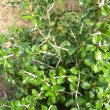| Botanical Name |
|
| Family |
|
| Pronunciation |
kah-too-NAH-ray-gum tay-LOR-ee-eye |
| Common Name(s) |
English: Thorny bone apple; Mountain Pomegranate
Afrikaans: Doringbeenappel
|
| Plant Group |
- Shrub A woody plant of relatively low height, having several stems arising from the base and lacking a single trunk; a bush.
|
| Plant Size |
- Medium to Large
| Tree | 15m to 20m |
| Shrub | 2m to 3m |
| Perennial/ground cover | 60cm to 75cm |
| Bulb | 60cm to 1m |
| Succulent | 60cm to 1m |
|
| Position |
- Canopy Shade Canopy shade is found below closely grown trees where some light filters through. Ideal for the protection of herbaceous plants.
- Dry Shade Shady areas where soil has poor water retention or are dependent on rain for their moisture needs.
- Light or Dappled Shade Found below trees with sparse, open foliage. Ideal for the protection of herbaceous plants.
- Partial Shade The area is in shade for part of the day and in full sun for part of the day.
- Sun The area is in full sun for all or most of the day, all year round.
|
| General Information |
- Drought Tolerance: High The plant is well adapted to arid conditions; it can survive long periods of drought and high temperatures without extra water.
- Evergreen Plants that have leaves all year round.
- Fragrant / Aromatic These plants posses a strong, usually pleasant odour.
- Frost: Tender A plant that will not survive any frost or low winter temperatures.
- Thorns / Spines / Prickles Thorn: A hard, woody, pointed branchlet.
Spine: A modified leaf forming a hard, sharp-pointed outgrowth.
Prickle: A small, sharp-pointed outgrowth growing from the bark of the plant.
- Water Wise Plant species originating from low rainfall regions that require less water to survive and thrive than other plant species.
- Wind Tolerant Plants able to withstand the effect of strong winds.
|
| Specific Information |
Catunaregam taylorii is a shrub or small tree which is armed with woody spines, usually in opposite pairs with a decussate arrangement along the stems - each pair of opposite thorns is set at a right angle to the pair below. As the tree ages the thorns may be more random and sometimes absent on the higher branches. The branches are stout and strong, forming rigid but graceful curved branches. Leaves cluster on the short side shoots. The flowers and fruits are edible, the raw fruits having a highly astringent taste due to a high tannin content.
|
| Ad Break |
|
| Flowers |
| Description |
slightly tubular flowers with five spreading lobes, up to 2.5 cm across, white changing to yellow after pollination
|
| Season |
- Autumn Plants will seldom bloom for the entire season as given in the list, but should flower during a period within these parameters.
|
| Colour |
|
| Growth Rate |
- Moderate Specifying growth rate can be very misleading as there is considerable variation of growth rate depending on type and species of plant, available water, supplementary feeding, mulching and general care, as well as the plants suitability and adaptability to the garden environment.
|
| Plant Uses |
- Attracts bees, butterflies or other insects This plant attracts insects which can be food for birds or other creatures in your garden.
- Attracts Birds This plant will attract birds.
- Barrier Plant A very thorny shrub, tree or scrambler that can be used to create an impenetrable barrier.
- Boundary A plant useful for planting around the edges of the property to form a green or colourful backdrop, an impenetrable hedge, to hide walls or create privacy.
- Filler Either a fast growing tree or shrub used temporarily to fill in an area while the permanent plants grow to a desired size, or a plant used to fill gaps in borders or beds.
- Hedge Suitable trees or shrubs planted relatively close together so that the branches intertwine to create a barrier. This can be formal – the plants are regularly trimmed to produce a neat shape, or informal – the plants are left to themselves to create a natural hedgerow.
- Provides light / dappled shade A tree with an open to sparse canopy, through which varying degrees of sunlight can penetrate.
- Rock Garden An area constructed of larger rocks, arranged naturally, to emphasise the use of stones as a main element. Generally plants used do not need a lot of care.
- Suitable for coastal gardens Plants adapted to dry, sandy soil, forceful wind, limited rainfall and intense sunlight.
- Wild Garden An indigenous garden planted for the benefit of wildlife and birds. Provides food, water, a variety of mini-biomes and no poisonous chemicals are used.
|
| Distribution and Habitat |
in South Africa in the provinces of KwaZulu-Natal, Limpopo and Mpumalanga, Swaziland, north to Mozambique, Zimbabwe, Zambia, Tanzania, Malawi, and the DRC, as well as India, in various types of woodland and scrub, overgrazed land, grassland, in sandy soils and on granite outcrops
NOTE: All of the resources I consulted indicate that this shrub does not grow further south than Port Shepston in KwaZulu-Natal. However, I have found them to be quite common in this area of the Eastern Cape, in the bush around Bathurst, in the Water's Meeting Reserve and in Martindale, near Grahamstown.
|
| Planting Suggestions |
For best results plant in a mixture of garden soil, a handful of bone-meal and compost. Mulch thickly and water well until established. I have observed that shaded or partially shaded specimens grow a little faster and have larger and greener leaves than those in full sun with no extra watering, which are slower growing with smaller, dark green leaves and a more rigid growth form.
|
| Medicinal Uses |
The seeds are used as a tonic to induce appetite and for relief from headache.The bark is used to treat diarrhea and dysentery. Powdered rind of the fruit is used to remove dandruff and for skin diseases.
|
| Ad Break |
|








Discuss this plant
Share knowledge, ask a question or give an experience.